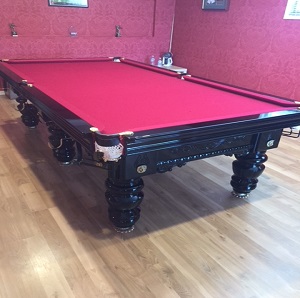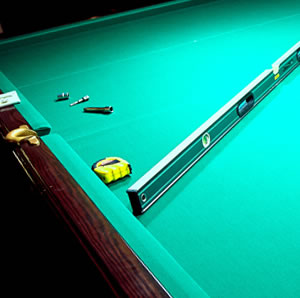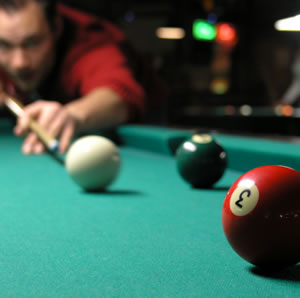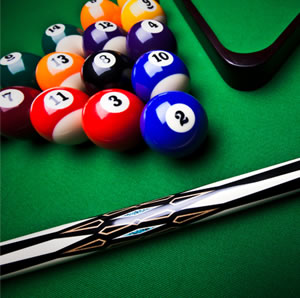Description
Snooker is played by two or more individuals, all using the same cue ball and 21 object balls (15 reds and 6 other coloured balls).
The order of the game dictates that strokes are taken alternately by players as they attempt to pot the 15 reds and then the colours in ascending order (Yellow to Black). Scoring strokes mean points and allow the player to continue his turn.
The player or side with the highest frame points total, or to whom the frame is conceded or awarded, is declared the victor. In turn, the player with the highest number of frames (or, less commonly, the highest aggregate points score) is the winner of the match.
Position of balls
The following image shows the starting points of all the object balls. The cue ball starts anywhere in the “D” on the Baulk-line:
- Reds - Form a tightly packed equilateral triangle which is positioned between the Black and Pink spots. The top red is situated jut below the Pink but without touching. The angle of the bottom triangle side is parallel with that of the bottom cushion.
- Yellow - Located at the right corner of the “D”.
- Green - Located at the left corner of the “D”.
- Brown - Located at the centre of the Baulk-line.
- Blue - Placed on the centre-spot.
- Pink - Placed on the pyramid spot.
- Black - Placed on ‘the spot’.
A ball in play may be cleaned by the referee at a player’s request. Its prior position will be marked by a device held by the referee (which you can see in televised matches).
Mode of play
The order shall be mutually agreed beforehand (either by a push-off with the cue ball or a coin toss), with the participants alternating turns to start the frame (known as ‘the break’ or ‘the break shot’).
The reds are potted and remain pocketed, but colours potted between reds will be respotted. The colours will only remain pocketed once the reds are all potted and if the coloured ball is the on ball.
If a player fails to score or commits a foul, his turn is over and the opponent continues from where the balls rest. If the cue ball is off the table, the player has ball in-hand and starts anywhere in the lines of the “D”.
End of frame
When just the black remains and points totals are such that the outcome depends on the pot, the next score or foul will end the frame unless the scores are then equal.
Playing from in-hand
This can only be done on or within the lines of the D, but whoever is in-hand can play the cue ball in any direction.
Hitting two balls simultaneously
This cannot be legally done in the first impact of the cue ball, unless they are two reds or a ball on and a free ball (see below).
Spotting colours
Balls will be respotted if forced off the table of or not part of the colour sequence at that point of the frame. If the spot is occupied, the colour will be placed on the next available spot with the closest valuation. If all are occupied then it will be placed as close as possible to its original location.
Touching ball
Should the cue ball come to rest while touching another ball, it will be announced as ‘touching ball’ by the referee. This means that the cue ball must be played away from the touching ball for the player to avoid a push shot foul. If the object ball does not move, there will be no penalty if the ball is on or if the cue ball hits another ball which he declares to be the on ball.
Ball on the edge of the pocket
If the ball falls without contact or without being part of a stroke, it will be replaced with no points score. If it would have been hit during the stroke then the balls will be replaced and the stroke may be played again.
If it balances momentarily and then falls, it counts as a pot.
Snookered after a foul
If a foul takes place and the cue ball rests in a snookered position, a free ball is called. This means the player may nominate any ball as the ball on, which will acquire the value of the actual ball on but will be respotted if potted. For example, if a player fouls while reds are on the table and the cue ball finishes in a snookered position, his opponent will be permitted to select any other ball on the table as a red and make contact without being penalised. However, the player must declare his intent and, if he asks the opponent to play again (see below), the call will be voided.
An interesting fact is that the free ball ruling means the maximum break, held to be 147, can theoretically be 155. If all 15 reds remain and a foul is committed which results in a snooker, a free ball will be nominated and, if potted for an extra point and then followed by a black (while all the reds remain on the table and the free ball is respotted), will mean 147 points remain with the break standing at 8 already!
Fouls
If the referee calls a foul then the striker’s turn ends, whether a stroke has been played or not. If a ball is forced off the table, it is respotted and, while all the points in the break beforehand count, no points can be awarded for the foul stroke.
If there are two fouls, the one with the highest penalty value is incurred.
The offending player can also be forced to play the next shot by his opponent.
Penalties
All fouls mean a minimum penalty of four points and a maximum of seven points (exempting situations where a frame or the match is awarded). The following is a list of the types of fouls you can expect to encounter, along with their respective penalties:
4 point penalties
- Striking the cue ball more than once.
- Striking the cue ball when both feet are off the floor.
- Playing the cue ball out of turn.
- Not following the proper regulations on playing the ball in-hand.
- Missing all the object balls after making contact with the cue ball.
- Causing the cue ball to enter any pocket.
- Placing a snooker behind a free ball.
- Playing a jump shot.
- Using a non-standard cue.
- Conferring with an unauthorised partner.
Ball on value penalties (4-7 points)
- Striking when any ball is not at rest.
- Striking the ball before the referee has respotted.
- Causing a ball which is not on to enter any pocket.
- Hitting a ball which is not on first.
- Committing a push stroke.
- Touching a ball in play other than the cue ball with the tip of the cue.
- Causing a ball to be forced off the table.
Highest value of the two penalties (4-7 points)
- Hitting two balls simultaneously with the cue ball on initial contact.
7 point penalties
- Using a ball off the table
- Using any object to measure gaps of distances.
- Playing at the reds in successive strokes (or a free ball and then a red).
- Using any ball as the cue ball other than the white.
- Failing to declare the on ball to the referee, or committing a foul before nominating a colour, or potting an unnominated colour.
Play again
Can be requested by a player after the opponent has committed a foul, but the player can then freely choose to play another shot or a pot.
Foul and a miss
Unquestionably the most contentious rule in snooker, and comparable to the offside rule in football or the LBW rule in cricket. This rule states that ‘the striker shall, to the best of his ability, endeavour to hit the ball on’. If the player commits a foul, the referee must subsequently decide if he has made the best effort to hit the ball on, rather than taking a complicated angle aiming more for tactical position after contact. For example, when there is a path in a straight line to any part of the ball on and the player chooses an alternate route.
If he decides this has not been achieved, he will award a ‘miss’ along with the four point penalty. This ruling means the player can choose to re-install his opponent in the snooker and force him to play again, with all the object balls and the cue ball in the same position. There are certain qualifications which mean a miss is not called though:
- If a player requires snookers, or snookers will subsequently be required.
- The miss was not ‘intentional’ (which is the chief problem, as the ruling is a subjective call by the referee).
- It is impossible to hit the ball on.
A further failure to hit the ball on will mean a repeat ‘miss’ call regardless of the scores, and a third failure means concession of the frame to the opponent. However, any foul prior to an attempt will not be called a miss (for example, touching the cue ball).
It is also worth noting that, while the object balls are nearly always replaced in their original position, the rule states this will only be the case if the offending player gains an advantage by their being moved.
Moreover, the balls can still only be touched by the referee, but both players will be consulted on the positioning before another attempt.
Ball moved by other than striker
Any circumstances causing this will mean repositioning and no penalty.
Stalemate
Any position adjudged a stalemate (a situation where there is no chance of the game progressing) by the referee will mean offering a re-rack (a frame restart) to both players. If refused, the referee will make it clear the situation must improve within a certain timeframe (typically, three shots for each player) or the restart will be forced.
Four-handed snooker
Refers to team snooker and basically means each side opens alternate frames and players on each side alternate turns.
Use of ancillary equipment
Any items brought to the table by the player are his responsibility and can be the cause of fouls while in use. Any equipment at the table is not the responsibility of the striker and no fouls may be called if it proves to be faulty.

 Ball!
Ball!




